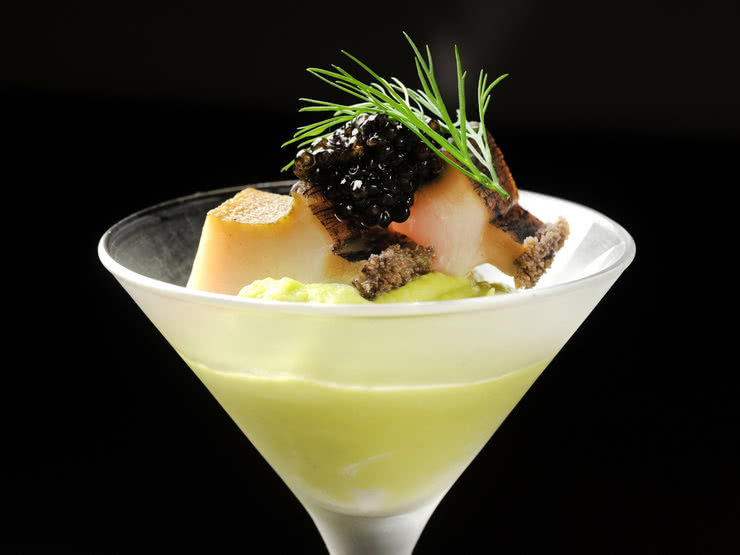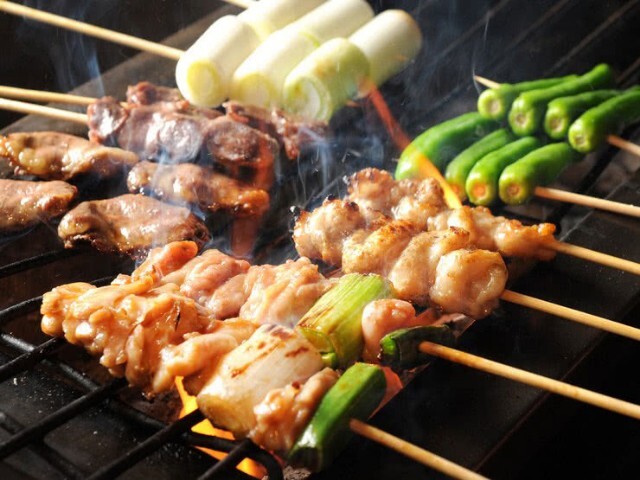![Kushiyaki Guide: How to Enjoy Japanese Skewered Cuisine]()
Skewered foods, known as kushiyaki, feature delectable bites of meat and vegetables that go perfectly with beer or sake. “Kushi” refers to the bamboo skewers used to spear the ingredients, while “yaki” means grilled or fried.
Eating grilled meat on sticks is a Japanese tradition that dates back to at least the 17th century. Although for some time eating meat was forbidden in Japan due to Buddhist conventions, during the Meiji period of modernization people began to eat meat again and shops specializing in grilled meat on skewers took off. In the period between WWI and WWII, the battered and deep-fried skewers known as kushiage or kushikatsu also became popular. Today, both grilled and fried kushiyaki can be savored with all kinds of meat and vegetables.
Continue reading Kushiyaki Guide: How to Enjoy Japanese Skewered Cuisine
![Where to Eat Yakitori in Tokyo (Japanese Grilled Chicken Skewers)]()
Yakitori is a popular type of Japanese food consisting of skewered chicken meat cooked typically over a charcoal grill, where “yaki” means to grill and “tori” is bird. The meat can come from all different parts of the chicken--from the neck, crest, breast, wings, heart, liver, and more. Vegetables such as shiitake mushrooms, green peppers and cherry tomatoes may also feature either with the chicken or separately on skewers. Yakitori is often flavored with salt or a soy sauce-based sauce known as tare, and is usually eaten as casual-style snack or meal with drinks. Read on to discover some of the best places for yakitori in Tokyo.
Continue reading Where to Eat Yakitori in Tokyo (Japanese Grilled Chicken Skewers)
![13 Exquisite French Restaurants in Tokyo]()
>It’s a well-known fact that the Japanese have a deep appreciation for all things French—fashion, interior design, art—and food is no exception. French food is one of the most popular international cuisines in Tokyo, Japan’s metropolitan dining capital, and offers everything from starred French dining to crêperies and small neighborhood cafés. Read on for 13 of Tokyo’s finest French restaurants.
Continue reading 13 Exquisite French Restaurants in Tokyo
![The Elegant Food of French-Japanese Fusion Cuisine]()
From flashy Michelin-starred establishments to cozy neighborhood bistros, the Japanese culinary affair with French cuisine is extensive. Japanese chefs have travelled to France to study cooking since the Meiji and Taisho Eras, and in the years since the 1960s those numbers have increased dramatically. These French-trained Japanese chefs bring with them the flavors and techniques of traditional French cuisine, as well as the influences of the ‘nouvelle’ cuisine that has become the gold standard in France since the 1920s, with its ingredient-focussed dishes, refined presentation and healthful emphasis.
Continue reading The Elegant Food of French-Japanese Fusion Cuisine
![Yokohama Chinatown Restaurants: 6 Great Gems of Chuka-ryori]()
Yokohama Chinatown, located about 30 minutes away from Tokyo by train, is the largest Chinatown in Japan and throughout Asia. The busy district was established in the late 1800s as an international port and today is a popular urban destination both for sightseeing and dining. Yokohama Chinatown is bordered by four colorful gates, one on each side, and contains over 250 Chinese-owned or Chinese-themed shops and restaurants within the space of about 300 square meters. It’s an excellent place to try various styles of Chinese food, from spicy Sichuan cuisine to Taiwanese Chinese food to the Japanese style of Chinese food known as chuka-ryori. Here are 6 Yokohama Chinatown restaurants that offer a tantalizing glimpse into the wide variety of Chinese cuisine that the area has to offer.
Continue reading Yokohama Chinatown Restaurants: 6 Great Gems of Chuka-ryori
![10 Italian Restaurants in Tokyo for Authentic & Inventive Dining]()
>Japan has long had an interest in Italian cuisine, dating back to the Meiji period when Italian “inspired” dishes like Napolitan spaghetti first became popular. In recent decades the focus has shifted from these reinterpretations of Italian dishes to more authentic Italian flavors and techniques. Beyond just flavor, the appeal of Italian food to Japanese chefs and diners may also be attributed to Italian cuisine’s emphasis on the heritage of food, the flavor of a mother’s cooking, and the use of locally grown and seasonal ingredients, which are also foundations of Japanese cuisine.
Continue reading 10 Italian Restaurants in Tokyo for Authentic & Inventive Dining
![8 Classic Japanese Italian Food Fusion Dishes for the Ages]()
One of the most internationally recognized and widespread cuisines, Italian food is also ingrained in Japanese society.
Both Japanese and Italian cuisine share common elements, most notably, an emphasis on seasonality and simplicity. Japanese-Italian food adds its characteristic attention to detail, and a light, delicate touch. Similar to the way French food has permeated Japanese cuisine, Italian food is both faithfully represented, and given Japanese accents, such as incorporates local ingredients like mentaiko, yuzu citrus, myoga native ginger, shiso leaf and sakura ebi.
Continue reading 8 Classic Japanese Italian Food Fusion Dishes for the Ages
![Shibuya Izakaya Guide: 7 Top-Tier Traditional Japanese Bars]()
An izakaya is Japan’s answer to a tavern or a pub, a casual dining establishment with reasonably priced food and accompanying drinks that is best enjoyed in groups. Like Shibuya restaurants in general, izakaya run the gamut from short-sleeved to sophisticated. Nowhere is the diversity of izakaya more apparent than in Shibuya, the city center most clearly embodying Tokyo’s flawless synergy of commerce and entertainment. There are several top quality izakaya all located within walking distance of Shibuya Station, making them ideal for after-work libations or for leisurely unwinding following a day spent shopping and sightseeing. Whatever your journey, here are 7 Shibuya izakaya that are well worth your time.
Continue reading Shibuya Izakaya Guide: 7 Top-Tier Traditional Japanese Bars
![10 Kyoto Izakaya: The "Spirits" of Tradition in Japan’s Old Capital]()
Over 1,200 years old, Japan’s most historic city and former capital is a top travel destination not only for its UNESCO world heritage sites but also for its amazing culinary delights. Kyoto has a vibrant nightlife, and the gastronomically inclined on an evening outing should look no further than one of Kyoto's many izakaya. An integral part of Japanese food culture both high and low, izakaya have long been the place where Japanese people go to unwind after a long day. For good food, good drinks, and a heavy dose of traditional Japan, here are 10 Kyoto izakaya that are sure to more than satisfy your epicurean desires.
Continue reading 10 Kyoto Izakaya: The "Spirits" of Tradition in Japan’s Old Capital
![Where to Eat Kaiseki in Tokyo]()
Kaiseki dining is Japan’s traditional haute cuisine, a tasting course of small, elegant dishes precisely prepared to evoke the flavors and imagery of the season. While Kyoto is the birthplace of kaiseki, Tokyo, with its world-class dining offers its own inimitable kaiseki dining scene, influenced by the cooking styles of various regions across Japan. Here are 11 must-try kaiseki restaurants from Japan’s metropolitan capital city.
Continue reading Where to Eat Kaiseki in Tokyo











